|
|
#781 |
|
⊙▃⊙
|
What's in the sky tonight?
December 21, 2013 -Today is the shortest day of the year in the Northern Hemisphere; the longest day in the Southern Hemisphere. Winter in the north, and summer in the south, begins at the solstice: 12:11 p.m. Eastern Standard Time. This is when the Sun reaches its farthest point south for the year and begins its six-month northward return. Happy Yule. -If there's one constellation that everyone should know at this time of year, it's wintry Orion climbing up in the east-southeast. As always when Orion is on the rise, the three-star Belt of Orion in its middle is nearly vertical. Show someone Orion this week and they'll know it for a lifetime. -On Dec. 19th, the European Space Agency launched one of the most ambitious astronomy missions ever: GAIA, an observatory that will survey more than one billion stars in the Milky Way. By the time GAIA's five year mission is over, astronomers will be able to build the first accurate three-dimensional map of celestial objects in our home galaxy. GAIA will do its work from the L2 Lagrange point approximately 1.5 million km from Earth. On Dec. 20th, amateur astronomer Dave Eagle of Higham Ferrers UK observed the spacecraft hurtling toward that distant station. "It was great to see the spacecraft in the exact position predicted, near the shield of Orion," says Eagle. "After watching the launch live on the Web in the morning, I was glad to be able to track it down and wish it well in its coming mission. It was much brighter than I expected, so its newly deployed Sun shield is doing a great job." Once it reaches its L2 parking orbit and begins observing, GAIA will log the position, brightness and color of every star that falls within its field of view. By repeating these observations throughout its mission, astronomers will be able to calculate the distance, speed and direction of motion of each star GAIA sees, chart variations in their brightness, and determine whether they have nearby companions. This kind of detailed information about the Milky Way is unprecedented and may lead to important new discoveries about the evolution and structure of our galaxy. For updates about GAIA, stay tuned to the ESA. http://www.spaceweather.com/images20...a.20131219.avi  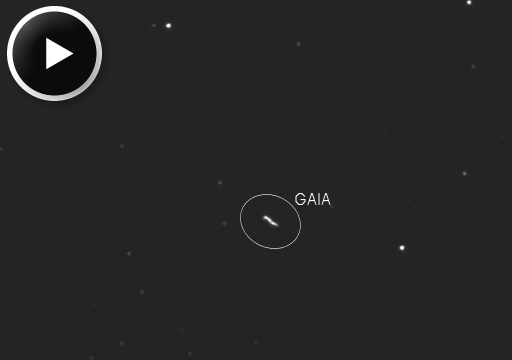 Astro Picture of the Day: December 21, 2013 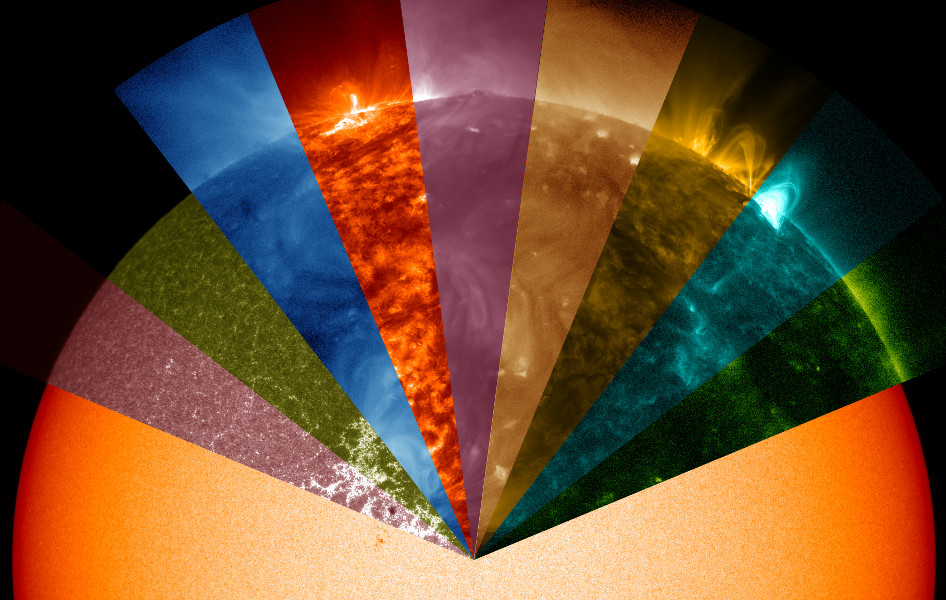 Today, the solstice is at 17:11 Universal Time, the Sun reaching the southernmost declination in its yearly journey through planet Earth's sky. The December solstice marks the astronomical beginning of winter in the northern hemisphere and summer in the south. To celebrate, explore this creative visualization of the Sun from visible to extreme ultraviolet wavelengths, using image data from the orbiting Solar Dynamics Observatory (SDO). Against a base image made at a visible wavelengths, the wedge-shaped segments show the solar disk at increasingly shorter ultraviolet and extreme ultraviolet wavelengths. Shown in false-color and rotating in a clockwise direction, the filters decrease in wavelength from 170 nanometers (in pink) through 9.4 nanometers (green). At shorter wavelengths, the altitude and temperature of the regions revealed in the solar atmosphere tend to increase. Bright at visible wavelengths, the solar photosphere looks darker in the ultraviolet, but sunspots glow and bright plasma traces looping magnetic fields. Watch the filters sweep around the solar disk in this animation of SDO's multiwavelength view of the Sun. http://svs.gsfc.nasa.gov/vis/a010000/a011300/a011385/
__________________
1st in Kommisar's 2009 SM Tournament 1st in I Love You`s 2009 New Year`s Tournament 3rd in EnR's Mashfest '08 tournament 5th in Phynx's Unofficial FFR Tournament 9th in D3 of the 2008-2009 4th Official FFR Tournament 10th in D5 of the 2010 5th Official FFR Tournament 10th in D6 of the 2011-2012 6th Official FFR Tournament FMO AAA Count: 71 FGO AAA Count: 10 Bluearrowll = The Canadian player who can not detect awkward patterns. If it's awkward for most people, it's normal for Terry. If the file is difficult but super straight forward, he has issues. If he's AAAing a FGO but then heard that his favorite Hockey team was losing by a point, Hockey > FFR PS: Cool AAA's Terry - I Love You An Alarm Clock's Haiku beep beep beep beep beep beep beep beep beep beep beep beep beep beep beep beep beep - ieatyourlvllol |
|
|

|
|
|
#782 |
|
⊙▃⊙
|
What's in the sky tonight?
December 22, 2013 -Earth is passing through a stream of debris from Comet 8P/Tuttle, source of the annual Ursid meteor shower. Forecasters expect the shower to peak on Dec. 22nd with as many as 10 meteors per hour streaming from a radiant near Polaris, the North Star. Occasionally, Earth hits a denser-than-usual patch of debris and rates increase 5- to 10-fold. However, no one can predict when these outbursts occur. -If you took a picture of the sun at the same time each day, would it remain in the same position? The answer is no, and the figure-8 shape traced out by the sun over the course of a year is called an analemma. Japanese photographer "Shiraishi" stitched together more than 50 pictures spanning 12 months to reveal the analemma of 2013 over the city of Kumagaya-shi in Saitama, Japan. "My analemma project started on December solstice in 2012 and finished on December solstice in 2013," says Shiraishi. "This photo contains the sun images from Jan. 18 to Dec. 22, that is, all the sun images are only in 2013." The upper and lower tips of the "8" represent the solstices-the longest and shortest days of the year. Today the Japanese sun is at the bottom. Winter has arrived! Other planets have analemmas, too. Not all are figure-8s, however. The shape depends on the tilt of the planet's spin axis and the eccentricity of its orbit around the sun. Martian analemmas resemble a teardrop, while Jupiter's analemma looks like a jelly-bean.  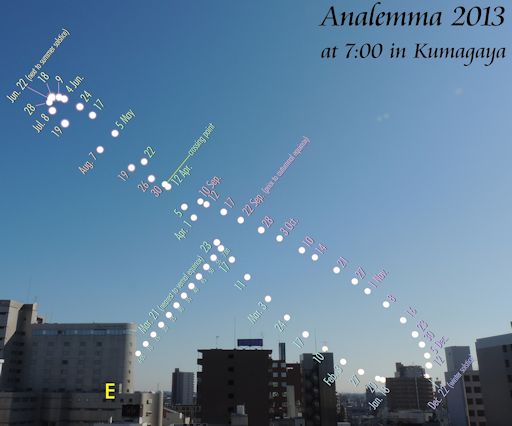 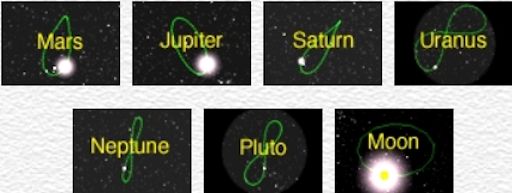 Astro Picture of the Day: December 22, 2013  If you went outside at exactly the same time every day and took a picture that included the Sun, how would the Sun's position change? With great planning and effort, such a series of images can be taken. The figure-8 path the Sun follows over the course of a year is called an analemma. Yesterday, the Winter Solstice day in Earth's northern hemisphere, the Sun appeared at the bottom of the analemma. Analemmas created from different latitudes would appear at least slightly different, as well as analemmas created at a different time each day. With even greater planning and effort, the series can include a total eclipse of the Sun as one of the images. Pictured is such a total solar eclipse analemma or Tutulemma - a term coined by the photographers based on the Turkish word for eclipse. The above composite image sequence was recorded from Turkey starting in 2005. The base image for the sequence is from the total phase of a solar eclipse as viewed from Side, Turkey on 2006 March 29. Venus was also visible during totality, toward the lower right.
__________________
1st in Kommisar's 2009 SM Tournament 1st in I Love You`s 2009 New Year`s Tournament 3rd in EnR's Mashfest '08 tournament 5th in Phynx's Unofficial FFR Tournament 9th in D3 of the 2008-2009 4th Official FFR Tournament 10th in D5 of the 2010 5th Official FFR Tournament 10th in D6 of the 2011-2012 6th Official FFR Tournament FMO AAA Count: 71 FGO AAA Count: 10 Bluearrowll = The Canadian player who can not detect awkward patterns. If it's awkward for most people, it's normal for Terry. If the file is difficult but super straight forward, he has issues. If he's AAAing a FGO but then heard that his favorite Hockey team was losing by a point, Hockey > FFR PS: Cool AAA's Terry - I Love You An Alarm Clock's Haiku beep beep beep beep beep beep beep beep beep beep beep beep beep beep beep beep beep - ieatyourlvllol |
|
|

|
|
|
#783 |
|
⊙▃⊙
|
What's in the sky tonight?
December 23, 2013 -With fall gone and winter here, the Great Square of Pegasus is again tipped up onto one corner after dinnertime, now descending on the western side of the sky. The main line of Andromeda's stars extends up from its top corner. -Big sunspot AR1928 is crackling with M-class solar flares. Magnetic fields spiraling away from the sunspot's location on the sun's western limb are well-connected to Earth, raising the possibility of a radiation storm around our planet if the flares intensify. NOAA forecasters estimate a 60% chance of M-class flares and a 10% chance of X-class flares on Dec. 23rd. -According to some scholars, the Star of Bethlehem might have been a close encounter between Venus and Jupiter. The two brightest planets in the night sky, merged, would have made a spectacle of Biblical proportions. This Christmas, NASA's STEREO-B probe is observing a conjunction of three planets-Venus, Earth and Jupiter. Unlike conjunctions of the distant past, this one includes our home planet. STEREO-B is located on the far side of the sun where it can look back and see Earth along with other worlds in the Solar System. Only NASA's twin STEREO probes, equipped with their high dynamic-range Heliospheric Imagers, can witness this kind of conjunction. From STEREO-B's point of view, Earth and Jupiter are less than 0.5 degrees apart, while all three planets fit in a circle 3 degrees in diameter. This meeting is not nearly as tight as the putative Star of Bethlehem conjunction ~2000 years ago. At that time Venus and Jupiter could have been as little as 6 arcseconds (0.00166 degrees) apart. Nevertheless, the ongoing conjunction is still a beauty. Stay tuned for updates as the three planets converge. 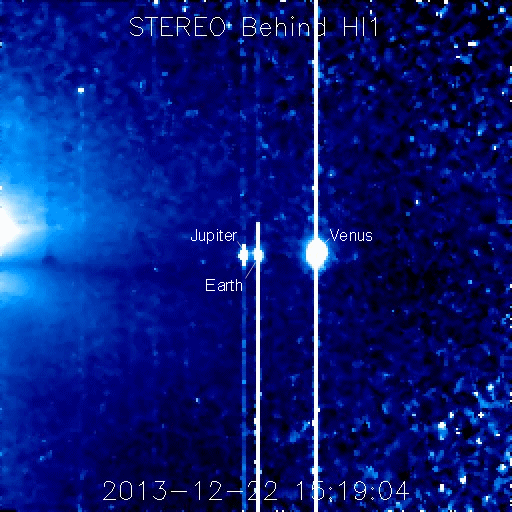 Astro Picture of the Day: December 23, 2013 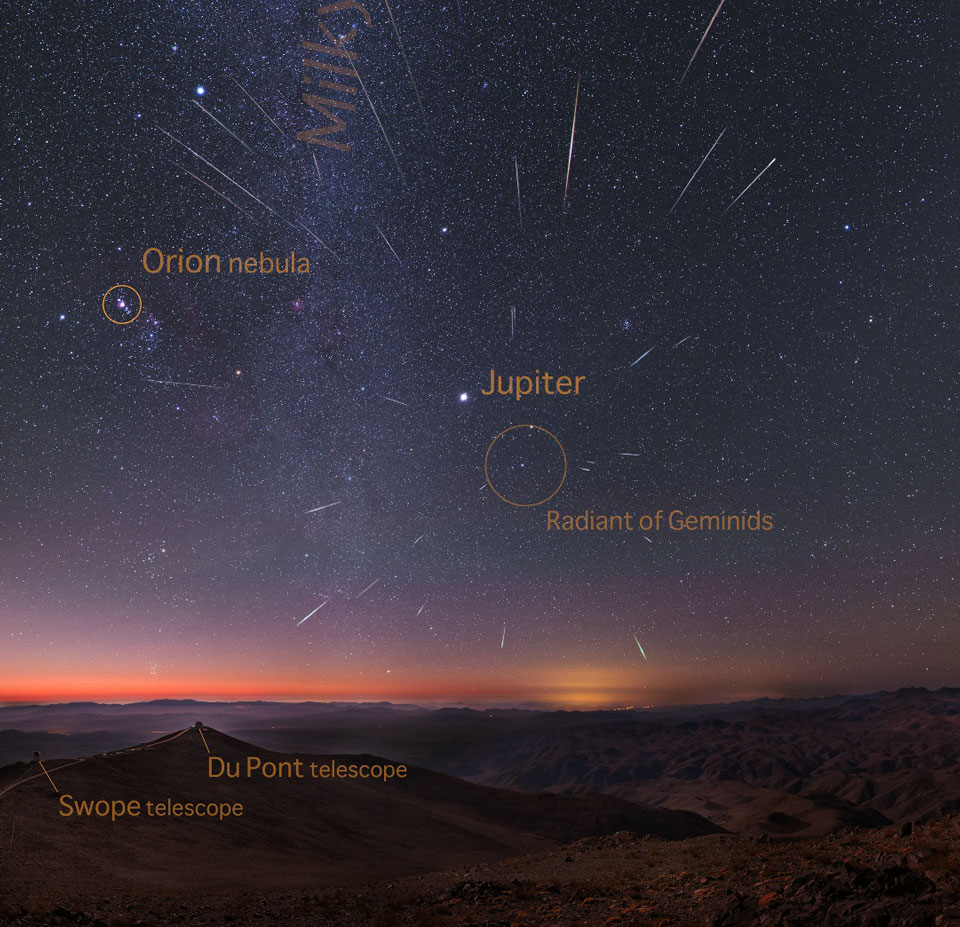 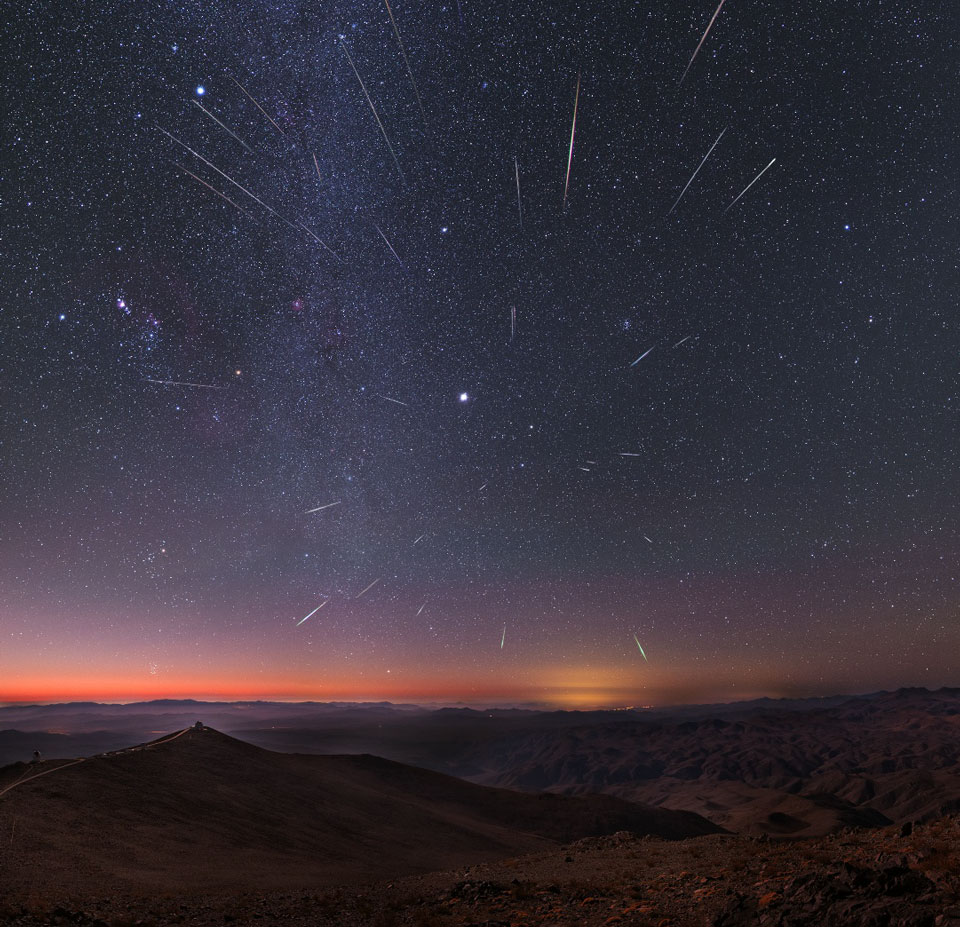 From a radiant point in the constellation of the Twins, the annual Geminid meteor shower rained down on planet Earth over the past few weeks. Recorded near the shower's peak over the night of December 13 and 14, the above skyscape captures Gemini's shooting stars in a four-hour composite from the dark skies of the Las Campanas Observatory in Chile. In the foreground the 2.5-meter du Pont Telescope is visible as well as the 1-meter SWOPE telescope. The skies beyond the meteors are highlighted by Jupiter, seen as the bright spot near the image center, the central band of our Milky Way Galaxy, seen vertically on the image left, and the pinkish Orion Nebula on the far left. Dust swept up from the orbit of active asteroid 3200 Phaethon, Gemini's meteors enter the atmosphere traveling at about 22 kilometers per second.
__________________
1st in Kommisar's 2009 SM Tournament 1st in I Love You`s 2009 New Year`s Tournament 3rd in EnR's Mashfest '08 tournament 5th in Phynx's Unofficial FFR Tournament 9th in D3 of the 2008-2009 4th Official FFR Tournament 10th in D5 of the 2010 5th Official FFR Tournament 10th in D6 of the 2011-2012 6th Official FFR Tournament FMO AAA Count: 71 FGO AAA Count: 10 Bluearrowll = The Canadian player who can not detect awkward patterns. If it's awkward for most people, it's normal for Terry. If the file is difficult but super straight forward, he has issues. If he's AAAing a FGO but then heard that his favorite Hockey team was losing by a point, Hockey > FFR PS: Cool AAA's Terry - I Love You An Alarm Clock's Haiku beep beep beep beep beep beep beep beep beep beep beep beep beep beep beep beep beep - ieatyourlvllol |
|
|

|
|
|
#784 |
|
⊙▃⊙
|
What's in the sky tonight?
December 24, 2013 -The last-quarter Moon shines near Mars after they rise late tonight and into the Christmas-morning dawn. -Big sunspot AR1928 is crackling with M-class solar flares. Magnetic fields spiraling away from the sunspot's location on the sun's western limb are well-connected to Earth, raising the possibility of a radiation storm around our planet if the flares intensify. NOAA forecasters estimate a 60% chance of M-class flares and a 10% chance of X-class flares on Dec. 23rd. -According to some scholars, the Star of Bethlehem might have been a close encounter between Venus and Jupiter. The two brightest planets in the night sky, merged, would have made a spectacle of Biblical proportions. This Christmas, NASA's STEREO-B probe is observing something similar. Instead of Jupiter and Venus merging, however, the combined planets are Jupiter and Earth. STEREO-B is located on the far side of the sun where it can look back and see Earth along with other planets in the Solar System. From STEREO-B's point of view, Earth and Jupiter are so close together that the spacecraft's Heliospheric Imager can barely tell the two apart. Venus is only 2 degrees from the Earth-Jupiter pair, so this is actually a 3-way conjunction. This meeting is not nearly as tight as the putative Star of Bethlehem conjunction ~2000 years ago. At that time Venus and Jupiter could have been as little as 6 arcseconds (0.00166 degrees) apart. Nevertheless, the ongoing display is still special because it's the first "Christmas Star conjunction" from space. Happy Holidays from STEREO! 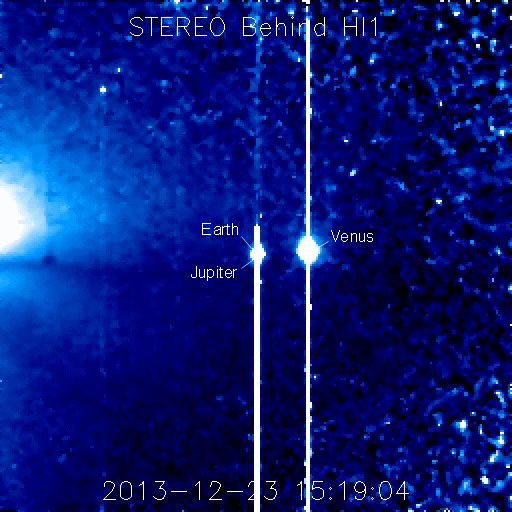 Astro Picture of the Day: December 24, 2013 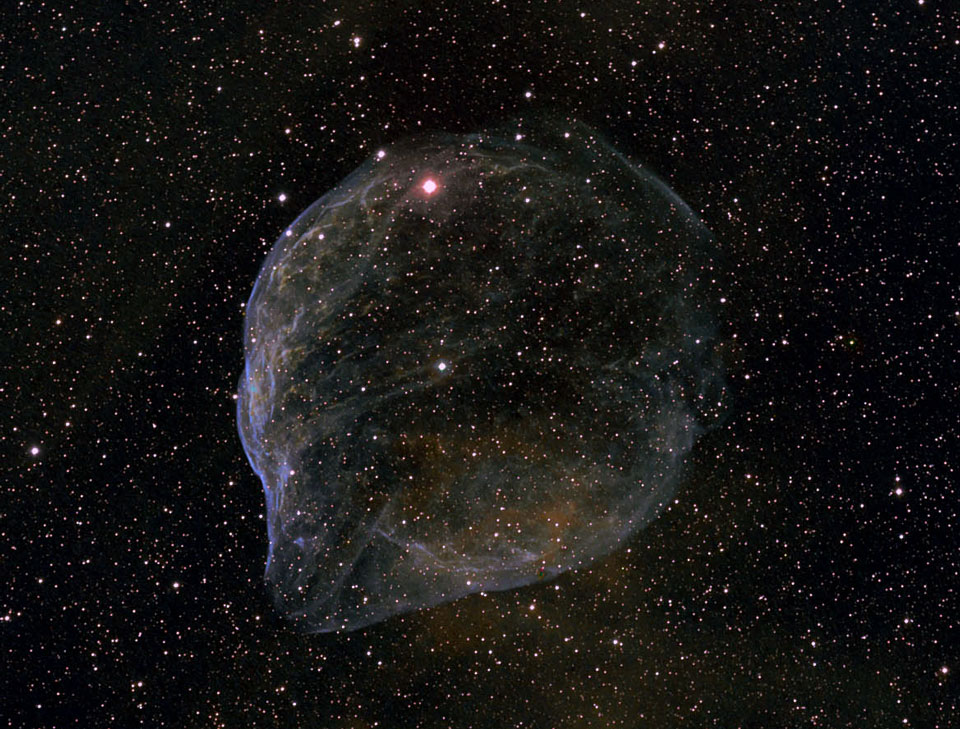 Blown by fast winds from a hot, massive star, this cosmic bubble is huge. Cataloged as Sharpless 2-308 it lies some 5,200 light-years away toward the constellation of the Big Dog (Canis Major) and covers slightly more of the sky than a Full Moon. That corresponds to a diameter of 60 light-years at its estimated distance. The massive star that created the bubble, a Wolf-Rayet star, is the bright one near the center of the nebula. Wolf-Rayet stars have over 20 times the mass of the Sun and are thought to be in a brief, pre-supernova phase of massive star evolution. Fast winds from this Wolf-Rayet star create the bubble-shaped nebula as they sweep up slower moving material from an earlier phase of evolution. The windblown nebula has an age of about 70,000 years. Relatively faint emission captured in the expansive image is dominated by the glow of ionized oxygen atoms mapped to violet hues.
__________________
1st in Kommisar's 2009 SM Tournament 1st in I Love You`s 2009 New Year`s Tournament 3rd in EnR's Mashfest '08 tournament 5th in Phynx's Unofficial FFR Tournament 9th in D3 of the 2008-2009 4th Official FFR Tournament 10th in D5 of the 2010 5th Official FFR Tournament 10th in D6 of the 2011-2012 6th Official FFR Tournament FMO AAA Count: 71 FGO AAA Count: 10 Bluearrowll = The Canadian player who can not detect awkward patterns. If it's awkward for most people, it's normal for Terry. If the file is difficult but super straight forward, he has issues. If he's AAAing a FGO but then heard that his favorite Hockey team was losing by a point, Hockey > FFR PS: Cool AAA's Terry - I Love You An Alarm Clock's Haiku beep beep beep beep beep beep beep beep beep beep beep beep beep beep beep beep beep - ieatyourlvllol |
|
|

|
|
|
#785 |
|
⊙▃⊙
|
What's in the sky tonight?
December 25, 2013 -At this time every year Sirius rises in the east-southeast down below Orion around 7 or 8 p.m. (depending on your location). When Sirius is still low, binoculars often show it twinkling in vivid colors. All stars do this when low, but Sirius is the brightest, making the effect more pronounced. -Merry Sol Invictus! In late Roman times when the solstice fell on December 25th, this date was celebrated as Dies Natalis Solis Invicti, the Birthday of the Unconquered Sun — when the Sun began to reverse its long decline with the hopeful promise, in the cold and the dark, of a new spring and summer to come. -From STEREO-B's point of view, Earth and Jupiter are less than 0.4 degrees apart, while all three planets fit in a circle 2 degrees in diameter. This meeting is not nearly as tight as the putative Star of Bethlehem conjunction ~2000 years ago. At that time Venus and Jupiter could have been as little as 6 arcseconds (0.00166 degrees) apart. Nevertheless, the ongoing display is still special because it's the first "Christmas Star conjunction" from space. -The star RS Puppis sparkles in the Southern Hemisphere, brightening by a factor of five roughly every six weeks. It’s a supergiant star, 200 times the size of the Sun and 15,000 times as luminous. And more importantly, it’s a Cepheid variable, a “standard candle” whose pulsations are inextricably linked to its luminosity and therefore to its distance. So astronomers were delighted to discover some time ago that the star is enshrouded in a veil of reflective dust, which is unusual for Cepheids. The gossamer nebula may be a remnant of the cloud in which the star formed. The nebula and the way the cepheid star interacts with it is shown in the video below.  Astro Picture of the Day: December 25, 2013  The graceful arc of the Milky Way begins and ends at two mountain peaks in this solemn night sky panorama. The view was created from a 24 frame mosaic, with exposures tracking Earth and sky separately. In the final composition, northern California's Mount Lassen was positioned at the left and Mount Shasta at the far right, just below the star and dust clouds of the galactic center. Lassen and Shasta are volcanoes in the Cascade Mountain Range of North America, an arc of the volcanic Pacific Ring of Fire. In the dim, snow-capped peaks, planet Earth seems to echo the subtle glow of the Milky Way's own faint, unresolved starlight.
__________________
1st in Kommisar's 2009 SM Tournament 1st in I Love You`s 2009 New Year`s Tournament 3rd in EnR's Mashfest '08 tournament 5th in Phynx's Unofficial FFR Tournament 9th in D3 of the 2008-2009 4th Official FFR Tournament 10th in D5 of the 2010 5th Official FFR Tournament 10th in D6 of the 2011-2012 6th Official FFR Tournament FMO AAA Count: 71 FGO AAA Count: 10 Bluearrowll = The Canadian player who can not detect awkward patterns. If it's awkward for most people, it's normal for Terry. If the file is difficult but super straight forward, he has issues. If he's AAAing a FGO but then heard that his favorite Hockey team was losing by a point, Hockey > FFR PS: Cool AAA's Terry - I Love You An Alarm Clock's Haiku beep beep beep beep beep beep beep beep beep beep beep beep beep beep beep beep beep - ieatyourlvllol |
|
|

|
|
|
#786 |
|
⊙▃⊙
|
What's in the sky tonight?
December 26, 2013 -Sirius sparkles low in the east-southeast after dinnertime. Procyon shines in the east about two fist-widths at arm's length to Sirius's left. If you live around north latitude 30° (Tijuana, New Orleans, Jacksonville), these Big and Little Dog Stars are at the same height above your horizon soon after they rise. If you're north of that latitude, Procyon will be higher. If you're south of there, Sirius leads. -Sunspot AR1934 has a 'beta-gamma' magnetic field that harbors energy for M-class solar flares. Because the region is directly facing Earth, any flares today would surely be geoeffective. The sunspot has been relatively quiet for days, however, so NOAA forecasters are estimating only a 25% chance of M-flares. -Christmas is over, but the amazing "Christmas conjunction" is still underway. As seen from NASA's STEREO-B spacecraft, the three planets Venus, Earth and Jupiter are clustered in a circle barely 2 degrees wide. The spacecraft's Heliospheric Imager took this picture on Dec. 26th. -Because of the holidays, this conjunction in space raises comparisons to a famous Christmas conjunction on Earth. According to some scholars, the Star of Bethlehem might have been a close encounter between Venus and Jupiter. The two brightest planets in the night sky, merged, would have made a spectacle so amazing that we still talk about it ~2000 years later. Unlike conjunctions of the distant past, this one includes our home planet. STEREO-B is located on the far side of the sun where it can look back and see Earth along with other worlds in the Solar System. From STEREO-B's point of view, Jupiter and Venus about 0.5 degrees apart. That is not nearly as tight as the putative Star of Bethlehem conjunction when those two planets were separated by as little as 6 arcseconds (0.00166 degrees). Nevertheless, the Christmas conjunction of 2013 is special because it includes Earth - the first time in history such a conjunction is possible. Happy holidays from STEREO!  Astro Picture of the Day: December 26, 2013  One of the most prominent nebulae in the night sky is M42, the Orion Nebula. Easily visible in plain sight outside of a city, it is the fuzzy middle “star” in Orion’s Sword. It is also the most famous reflection nebula in the sky. Note that, as with most deep-sky objects, the nebula appears gray because our eyes don't perceive colour in dim light. Cameras however, are able to detect the luminous colours found in the region. This particular composite photo is a 55 image stack of the M42 region in order to really bring out as much detail as possible in the nebula. But without an astrotrac or equatorial mount, this is about as sharp an image as I can expect in the attempt to avoid star trails. The photo was taken on a chilly -24C night on December 24, which is ideal for astrophotography because colder nights generally have better seeing conditions, taking away from distortion that the atmosphere may impose on the images.
__________________
1st in Kommisar's 2009 SM Tournament 1st in I Love You`s 2009 New Year`s Tournament 3rd in EnR's Mashfest '08 tournament 5th in Phynx's Unofficial FFR Tournament 9th in D3 of the 2008-2009 4th Official FFR Tournament 10th in D5 of the 2010 5th Official FFR Tournament 10th in D6 of the 2011-2012 6th Official FFR Tournament FMO AAA Count: 71 FGO AAA Count: 10 Bluearrowll = The Canadian player who can not detect awkward patterns. If it's awkward for most people, it's normal for Terry. If the file is difficult but super straight forward, he has issues. If he's AAAing a FGO but then heard that his favorite Hockey team was losing by a point, Hockey > FFR PS: Cool AAA's Terry - I Love You An Alarm Clock's Haiku beep beep beep beep beep beep beep beep beep beep beep beep beep beep beep beep beep - ieatyourlvllol |
|
|

|
|
|
#787 |
|
⊙▃⊙
|
What's in the sky tonight?
December 27, 2013 -Venus (about –4.5) is dropping lower in evening twilight every day. Look southwest. Optical aid shows it becoming an ever thinner crescent: from 7% sunlit on December 27th to just 2% lit on January 4th. But it's big! —about 59 arcminutes in diameter. Good binoculars will show its crescent shape in twilight. -The best time to observe Venus in a telescope is well before sunset. Hide the Sun behind a building so you can't accidentally sweep it into your view. See this article on more information about Venus's inferior onjunction. http://www.skyandtelescope.com/obser...236245001.html Venus is heading to inferior conjunction with the Sun on January 11th. -Two sunspots facing Earth (AR1934 and AR1936) have 'beta-gamma' magnetic fields that harbor energy for strong flares. Both sunspots have been quiet for days, however, and they show no signs of an imminent eruption. This has prompted NOAA forecasters to place low odds on flares today: a 25% chance of M-flares and a 1% chance X-flares. Astro Picture of the Day: December 27, 2013 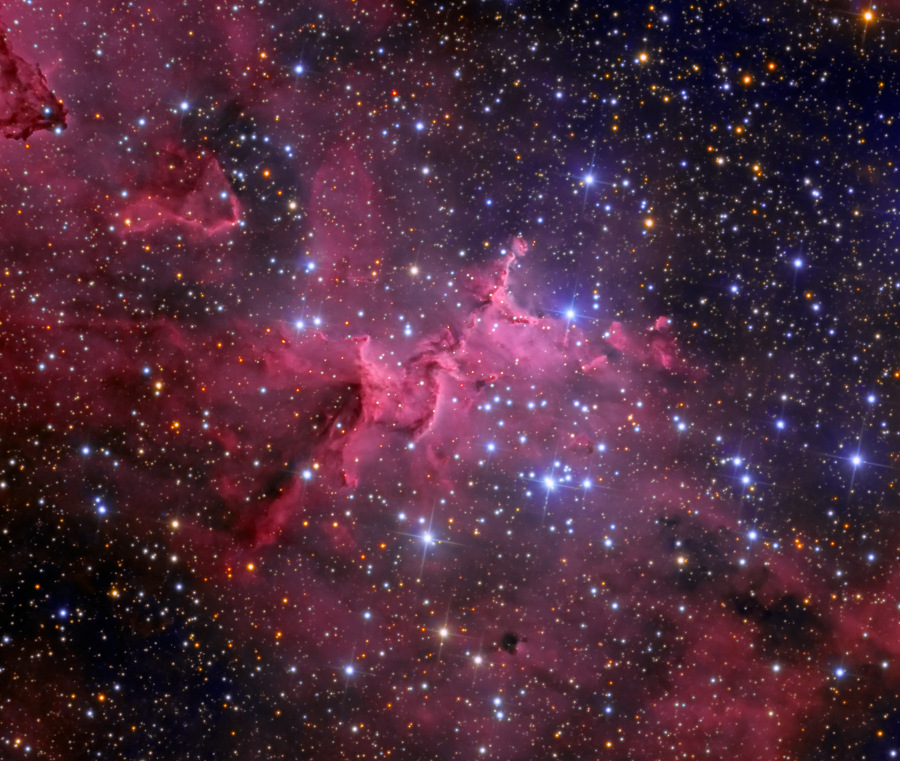 Cosmic clouds seem to form fantastic shapes in the central regions of emission nebula IC 1805. Of course, the clouds are sculpted by stellar winds and radiation from massive hot stars in the nebula's newborn star cluster, Melotte 15. About 1.5 million years young, the cluster stars are near the center of this colorful skyscape, along with dark dust clouds in silhouette. Dominated by emission from atomic hydrogen, the telescopic view spans about 30 light-years. But wider field images reveal that IC 1805's simpler, overall outline suggests its popular name - The Heart Nebula. IC 1805 is located along the northern Milky Way, about 7,500 light years distant toward the constellation Cassiopeia.
__________________
1st in Kommisar's 2009 SM Tournament 1st in I Love You`s 2009 New Year`s Tournament 3rd in EnR's Mashfest '08 tournament 5th in Phynx's Unofficial FFR Tournament 9th in D3 of the 2008-2009 4th Official FFR Tournament 10th in D5 of the 2010 5th Official FFR Tournament 10th in D6 of the 2011-2012 6th Official FFR Tournament FMO AAA Count: 71 FGO AAA Count: 10 Bluearrowll = The Canadian player who can not detect awkward patterns. If it's awkward for most people, it's normal for Terry. If the file is difficult but super straight forward, he has issues. If he's AAAing a FGO but then heard that his favorite Hockey team was losing by a point, Hockey > FFR PS: Cool AAA's Terry - I Love You An Alarm Clock's Haiku beep beep beep beep beep beep beep beep beep beep beep beep beep beep beep beep beep - ieatyourlvllol |
|
|

|
|
|
#788 |
|
⊙▃⊙
|
What's in the sky tonight?
December 28, 2013 -Very late tonight, tomorrow, and Monday nights, Mars is just 3/4° from Gamma Virginis (Porrima), magnitude 2.7 — a famous close double star for telescopes at high power. Mars and Gamma Vir rise together after midnight and are best seen high in the south before dawn. -Dawn is now coming its latest of the year. Step out early enough and you can watch the waning Moon passing Saturn and Antares. -This week, there was a storm on Jupiter - a radio storm. Amateur radio astronomer Thomas Ashcraft recorded the event on Dec. 23rd using a shortwave radio telescope located in New Mexico. Here is what he captured: http://www.spaceweather.com/images20..._Ashcraft1.mp3 -"Although few were aware of it, Earth was bathed in Jovian radio beams for an hour and half," says Ashcraft. "The audio recording captures the sounds I heard during one minute around 09:30 UT." Jupiter's radio storms are caused by natural radio lasers in the planet's magnetosphere that sweep past Earth as Jupiter rotates. Electrical currents flowing between Jupiter's upper atmosphere and the volcanic moon Io can boost these emissions to power levels easily detected by ham radio antennas on Earth. Jovian "S-bursts" (short bursts) and "L-bursts" (long bursts) mimic the sounds of woodpeckers, whales, and waves crashing on the beach. S-Burst: http://radiojove.gsfc.nasa.gov/obser...s/sbursts1.wav S-Bursts slowed down 128:1: http://radiojove.gsfc.nasa.gov/obser...ts1_slowed.wav L-Burst: http://radiojove.gsfc.nasa.gov/obser...s/lbursts1.wav -Now is a good time to listen to Jupiter's radio storms. The distance between Earth and Jupiter is decreasing as the giant planet approaches opposition on Jan. 5th; and the closer Jupiter comes, the louder it gets. Jupiter is a bit like a lighthouse. It is possible to predict when the planet's most intense radio beams will sweep past Earth. The next storm is due on Dec. 30th between 10:00 and 11:00 UT.  Astro Picture of the Day: December 28, 2013 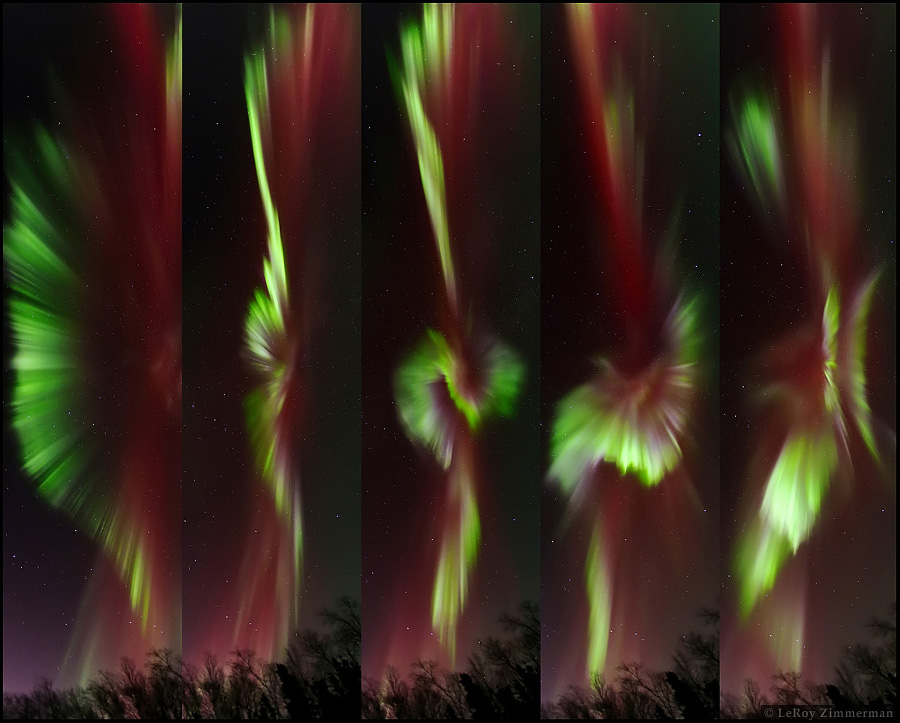 A remarkably intense auroral band flooded the northern night with shimmering colors on December 7. The stunning sequence captured here was made with a camera fixed to a tripod under cold, clear skies near Ester, just outside of Fairbanks, Alaska. Left to right, spanning a period of about 30 minutes, the panels follow changes in the dancing curtains of northern lights extending to altitudes of over 100 kilometers in a band arcing directly overhead. The panels span 150 degrees vertically, covering about 500 kilometers of aurora laying across the sky from edge to edge. The auroral activity was triggered by a moderate level geomagnetic storm, as a high speed solar wind stream buffeted planet Earth's magnetosphere.
__________________
1st in Kommisar's 2009 SM Tournament 1st in I Love You`s 2009 New Year`s Tournament 3rd in EnR's Mashfest '08 tournament 5th in Phynx's Unofficial FFR Tournament 9th in D3 of the 2008-2009 4th Official FFR Tournament 10th in D5 of the 2010 5th Official FFR Tournament 10th in D6 of the 2011-2012 6th Official FFR Tournament FMO AAA Count: 71 FGO AAA Count: 10 Bluearrowll = The Canadian player who can not detect awkward patterns. If it's awkward for most people, it's normal for Terry. If the file is difficult but super straight forward, he has issues. If he's AAAing a FGO but then heard that his favorite Hockey team was losing by a point, Hockey > FFR PS: Cool AAA's Terry - I Love You An Alarm Clock's Haiku beep beep beep beep beep beep beep beep beep beep beep beep beep beep beep beep beep - ieatyourlvllol |
|
|

|
|
|
#789 |
|
⊙▃⊙
|
What's in the sky tonight?
December 29, 2013 -Energetic protons are swarming around Earth on Dec. 29th following a magnetic eruption near the western limb of the sun. The ongoing radiation storm ranks S1 on NOAA storm scales, which means it is a relatively minor storm with little effect on spacecraft and high-altitude aviation. -Now is a great time to look at the second planet from the sun. Like the Moon, Venus has phases, and at the moment it is a 6% crescent. Moreover, it is bright enough to see in broad daylight. Yesterday, Mark Wloch pointed his Celestron C8 telescope at the blue sky over Southgate, Michigan, and this is what he saw. "I captured Venus during daylight with a jet passing by," says Wloch. "What a beautiful conjunction." Yes, it is easy to see Venus in broad daylight, but it is even easier to see the planet at sunset when Venus pierces the darkening sky like a beacon 150 times brighter than a 1st-magnitude star. Indeed, some sky watchers think Venus is an airplane. A quick look through a pair of binoculars, however, reveals the crescent. Point your optics southwest after sunset. No sky map is required; you can't miss Venus. -AR1936 is waking up. The sunspot has a 'beta-gamma-delta' magnetic field that harbors energy for strong eruptions, yet it has been quiet for days. Now AR1936 is beginning to crackle with flares. NASA's Solar Dynamics Observatory recorded the extreme ultraviolet flash from an almost-M-class flare at 1800 UT on Dec. 28th. Because the sunspot is facing Earth, any flares emanating from it are going to be geoeffective. So far, the extreme ultraviolet "crackles" have produced only minor waves of ionization in our planet's upper atmosphere. Earth-effects will increase, however, if the activity continues to intensify. Stay tuned!  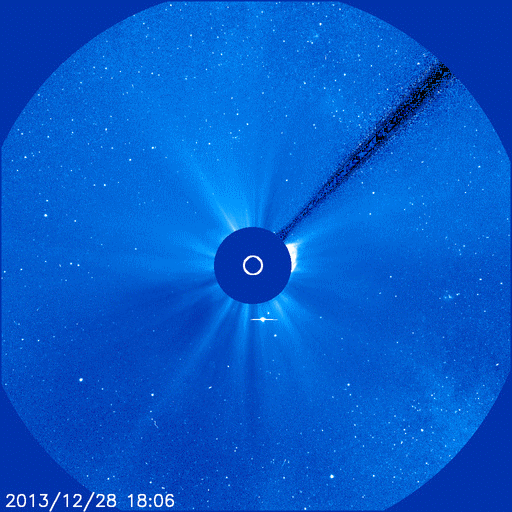 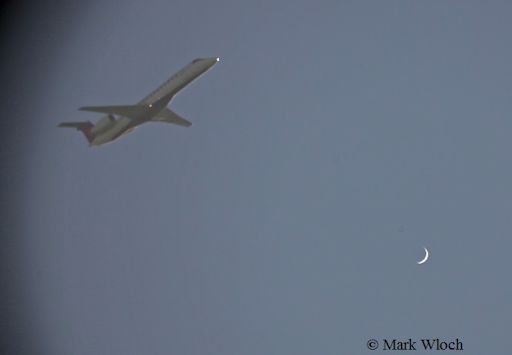 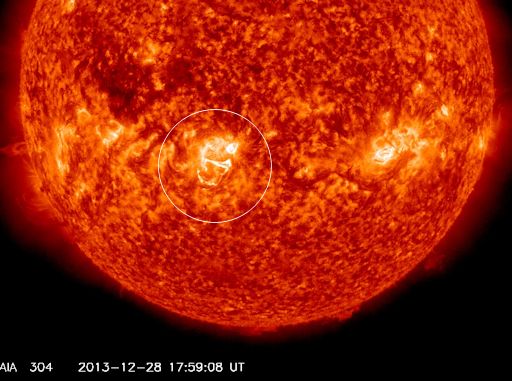 Astro Picture of the Day: December 29, 2013 Source: Sometimes, after your eyes adapt to the dark, a spectacular sky appears. Such was the case in 2011 March when one of the largest auroral displays in recent years appeared over northern locations like the border between Norway and Russia. Pictured in the above time-lapse movie, auroras flow over snow covered landscapes, trees, clouds, mountains and lakes found near Kirkenes, Norway. Many times the auroras are green, as high energy particles strike the Earth's atmosphere, causing the air to glow as electrons resettle into their oxygen hosts. Other colors are occasionally noticeable as atmospheric nitrogen also becomes affected. In later sequences the Moon and rising stars are also visible. With the Sun currently hovering near its time of maximum activity, there may be many opportunities to see similarly spectacular auroras personally, even from areas much closer to the equator.
__________________
1st in Kommisar's 2009 SM Tournament 1st in I Love You`s 2009 New Year`s Tournament 3rd in EnR's Mashfest '08 tournament 5th in Phynx's Unofficial FFR Tournament 9th in D3 of the 2008-2009 4th Official FFR Tournament 10th in D5 of the 2010 5th Official FFR Tournament 10th in D6 of the 2011-2012 6th Official FFR Tournament FMO AAA Count: 71 FGO AAA Count: 10 Bluearrowll = The Canadian player who can not detect awkward patterns. If it's awkward for most people, it's normal for Terry. If the file is difficult but super straight forward, he has issues. If he's AAAing a FGO but then heard that his favorite Hockey team was losing by a point, Hockey > FFR PS: Cool AAA's Terry - I Love You An Alarm Clock's Haiku beep beep beep beep beep beep beep beep beep beep beep beep beep beep beep beep beep - ieatyourlvllol |
|
|

|
|
|
#790 |
|
⊙▃⊙
|
What's in the sky tonight?
December 30, 2013 -When evening twilight turns to night at year's end, the constellation Andromeda is crossing the zenith (for the world's mid-northern latitudes). The Great Andromeda Galaxy passes right through your zenith if you're near latitude 41° north (New York, Denver, Madrid). This happens at 6:05 p.m. tonight if you live at your time zone's standard longitude. If you're east or west of there, as you probably are, the galaxy will transit as much as 30-plus minutes earlier or later, respectively. Lie on your back and look straight up with binoculars for a dim, elongated little glow of fuzzy gray among the pinpoint stars. -Energetic protons are swarming past Earth in the aftermath of a magnetic explosion on the sun's western limb on Dec. 28th: movie. At its peak, the radiation storm registered "S1" on NOAA storm scales, which is to say it was a minor event with minimal effects on Earth-orbiting satellites and aviation. The storm is subsiding now. Stronger radiation storms are possible in the days ahead, however, as potent sunspot AR1934 rotates toward the western limb--a place with a strong magnetic connection to Earth. Flares from AR1934 could send more protons in our direction. -Magnetic fields in the sun's northern hemisphere have opened up, creating a vast hole in the sun's atmosphere - a coronal hole. NASA's Solar Dynamics Observatory is monitoring the UV-dark gap. Coronal holes are places where magnetic fields threading through the sun's atmosphere spread apart and allow solar wind to escape. A stream of solar wind flowing from this particular coronal hole could reach Earth on Jan. 2-3, possibly sparking polar geomagnetic storms. The first auroras of 2014 are in the offing.   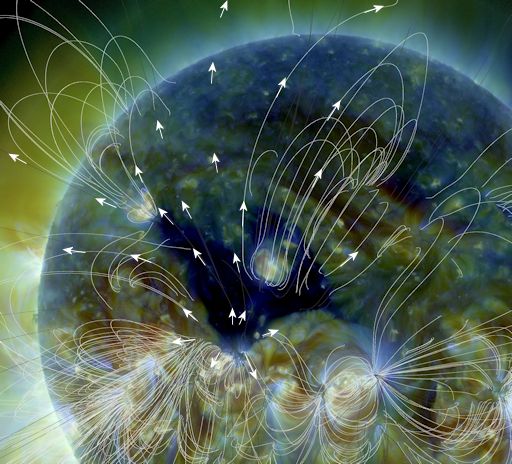 Astro Picture of the Day: December 30, 2013   Gorgeous spiral galaxy M33 seems to have more than its fair share of glowing hydrogen gas. A prominent member of the local group of galaxies, M33 is also known as the Triangulum Galaxy and lies about 3 million light-years distant. Its inner 30,000 light-years are shown in this telescopic galaxy portrait that enhances the reddish ionized hydrogen clouds or HII regions. Sprawling along loose spiral arms that wind toward the core, M33's giant HII regions are some of the largest known stellar nurseries, sites of the formation of short-lived but very massive stars. Intense ultraviolet radiation from the luminous, massive stars ionizes the surrounding hydrogen gas and ultimately produces the characteristic red glow. To enhance this image, broadband data was used to produce a color view of the galaxy and combined with narrowband data recorded through a hydrogen-alpha filter, transmitting the light of the strongest hydrogen emission line.
__________________
1st in Kommisar's 2009 SM Tournament 1st in I Love You`s 2009 New Year`s Tournament 3rd in EnR's Mashfest '08 tournament 5th in Phynx's Unofficial FFR Tournament 9th in D3 of the 2008-2009 4th Official FFR Tournament 10th in D5 of the 2010 5th Official FFR Tournament 10th in D6 of the 2011-2012 6th Official FFR Tournament FMO AAA Count: 71 FGO AAA Count: 10 Bluearrowll = The Canadian player who can not detect awkward patterns. If it's awkward for most people, it's normal for Terry. If the file is difficult but super straight forward, he has issues. If he's AAAing a FGO but then heard that his favorite Hockey team was losing by a point, Hockey > FFR PS: Cool AAA's Terry - I Love You An Alarm Clock's Haiku beep beep beep beep beep beep beep beep beep beep beep beep beep beep beep beep beep - ieatyourlvllol |
|
|

|
|
|
#791 |
|
⊙▃⊙
|
What's in the sky tonight?
December 31, 2013 -After the New Year's cheering at midnight, step outside into the silent dark. Sirius shines almost due south. Jupiter, even brighter, beams much higher to the south. Orion strides to the upper right of Sirius. Procyon shines to Sirius's upper left, and Leo is climbing the eastern sky. News Posted Today: December 30, 2013 Meteor Showers in 2014  Astro Picture of the Day: December 31, 2013 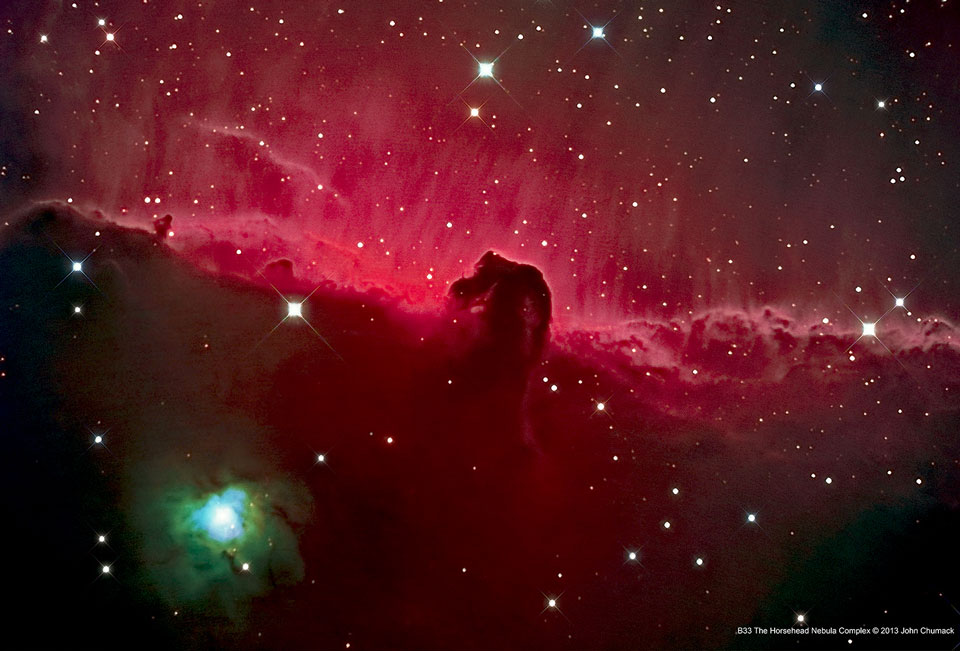 The Horsehead Nebula is one of the most famous nebulae on the sky. It is visible as the dark indentation to the red emission nebula in the center of the above photograph. The horse-head feature is dark because it is really an opaque dust cloud that lies in front of the bright red emission nebula. Like clouds in Earth's atmosphere, this cosmic cloud has assumed a recognizable shape by chance. After many thousands of years, the internal motions of the cloud will alter its appearance. The emission nebula's red color is caused by electrons recombining with protons to form hydrogen atoms. Also visible at the bottom left of the picture is a greenish reflection nebulae that preferentially reflects the blue light from nearby stars.
__________________
1st in Kommisar's 2009 SM Tournament 1st in I Love You`s 2009 New Year`s Tournament 3rd in EnR's Mashfest '08 tournament 5th in Phynx's Unofficial FFR Tournament 9th in D3 of the 2008-2009 4th Official FFR Tournament 10th in D5 of the 2010 5th Official FFR Tournament 10th in D6 of the 2011-2012 6th Official FFR Tournament FMO AAA Count: 71 FGO AAA Count: 10 Bluearrowll = The Canadian player who can not detect awkward patterns. If it's awkward for most people, it's normal for Terry. If the file is difficult but super straight forward, he has issues. If he's AAAing a FGO but then heard that his favorite Hockey team was losing by a point, Hockey > FFR PS: Cool AAA's Terry - I Love You An Alarm Clock's Haiku beep beep beep beep beep beep beep beep beep beep beep beep beep beep beep beep beep - ieatyourlvllol |
|
|

|
|
|
#792 |
|
⊙▃⊙
|
With the new year comes a new addition to this thread, as well as a subtraction. I am removing the "Upcoming Events" tab from the main post because I found I was posting the information to the "What's in the Sky Tonight?" tab anyway, renderring this tab redundant and unnecessary.
In its place, I am adding the daily posting of Suspicious0bserver's weather news around the world. What is significant about this channel's weather postings is that not only does it use interactive weather maps that are free to access around the internet, all the links are posted on his daily videos. Furthermore, he attempts to make connections between spaceweather and Earth weather. One such connection is the correlation between solar behaviour and earthquakes here. This channel frequently suspects that the interaction between magnetic forces from the Sun versus the Earth are a key factor in the causation of earthquakes, and the data provided in daily space/earth weather does seem to agree with this. Also included in this channel, there will be the occasional professional journal release for those who are interested in reading them. I can't necessarily say what they will be about yet as I haven't yet visited this channel long enough to identify a pattern. Daily Suspicious0bserver's Weather Post: January 1, 2014 What's in the sky tonight? January 1, 2014 -New Moon (exact at 6:14 a.m. EST). -Shortly after the Sun sets, in central and western North America you can try to spot what will almost certainly be your personal record-young crescent Moon, perhaps for the rest of your life. An extremely thin trace of the Moon will be almost straight above the sunset point — and conveniently for locating it, 8° to 9° lower right of Venus. And the Moon is at perigee. -The sighting will probably be impossible from the East Coast, where the Moon will be just 11 hours old and only 7° from the Sun a half hour after sunset. But it might be possible through a telescope in the Central time zone if the air is very clear. It should be possible with binoculars on the West Coast, where the Moon will be approximately 14 hours old and 8.5° from the Sun. Figure its age from the time of new Moon: 11:14 UT (3:14 a.m. Pacific Standard Time). -Go out early to mark where the Sun sets, then set up your equipment and start watching no more than 15 minutes after sundown. Keep watching for another 25 minutes to catch your window of best visibility, which will depend on your location and atmospheric conditions. This article has some great information on how to spot the extremely thin crescent: http://www.skyandtelescope.com/obser...s/3308686.html -2013 ended with a bang. At 21:58 UT on Dec. 31st, sunspot AR1936 erupted, producing a strong M6-class solar flare. NASA's Solar Dynamics Observatory recorded the extreme ultraviolet flash. Amateur images of the explosion show a dark filament of plasma flying away from the blast site. Indeed, the explosion probably hurled a coronal mass ejection (CME) into space. The putative CME could deliver a glancing blow to Earth's magnetic field later this week. We'll find out more about this possibility when coronagraph data from SOHO and STEREO reach Earth. Stay tuned. Meanwhile, more flares are in the offing. Sunspot AR1936 has a 'beta-gamma-delta' magnetic field that harbors energy for strong eruptions. NOAA forecasters estimate a 40% chance of M-class flares and a 10% chance of X-flares on Jan. 1st. 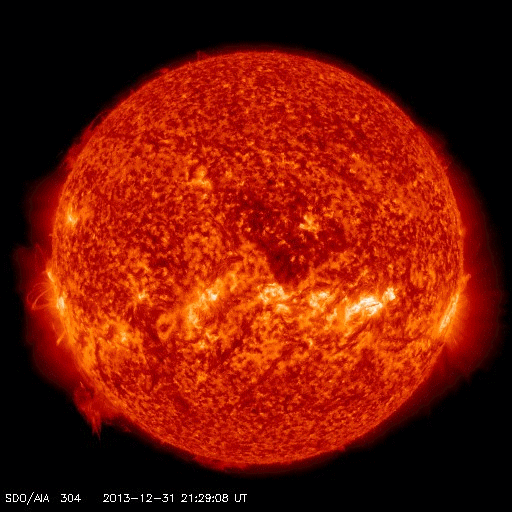 News Posted Today: December 30, 2013 Eclipses in 2014  Astro Picture of the Day: January 1, 2014  That's not the young crescent Moon poised above the western horizon at sunset. Instead it's Venus in a crescent phase, captured with a long telephoto lens from Quebec City, Canada, planet Earth on a chilly December 30th evening. The very bright celestial beacon is droping lower into the evening twilight every day. But it also grows larger in apparent size and becomes a steadily thinner crescent in binocular views as it heads toward an inferior conjunction, positioned between the Earth and the Sun on January 11. The next few evenings will see a young crescent Moon join the crescent Venus in the western twilight, though. Historically, the first observations of the phases of Venus were made by Galileo with his telescope in 1610, evidence consistent with the Copernican model of the Solar System, but not the Ptolemaic system.
__________________
1st in Kommisar's 2009 SM Tournament 1st in I Love You`s 2009 New Year`s Tournament 3rd in EnR's Mashfest '08 tournament 5th in Phynx's Unofficial FFR Tournament 9th in D3 of the 2008-2009 4th Official FFR Tournament 10th in D5 of the 2010 5th Official FFR Tournament 10th in D6 of the 2011-2012 6th Official FFR Tournament FMO AAA Count: 71 FGO AAA Count: 10 Bluearrowll = The Canadian player who can not detect awkward patterns. If it's awkward for most people, it's normal for Terry. If the file is difficult but super straight forward, he has issues. If he's AAAing a FGO but then heard that his favorite Hockey team was losing by a point, Hockey > FFR PS: Cool AAA's Terry - I Love You An Alarm Clock's Haiku beep beep beep beep beep beep beep beep beep beep beep beep beep beep beep beep beep - ieatyourlvllol |
|
|

|
|
|
#793 |
|
⊙▃⊙
|
Daily Suspicious0bserver's Weather Post:
January 2, 2014 What's in the sky tonight? January 2, 2014 -As twilight starts to fade, look for the thin crescent Moon (24 hours older now, much easier than yesterday) above Venus low in the southwest, as shown at right. Venus too is a (tiny) crescent. The two crescents face almost the same way toward their light source, the Sun. (In parts of western North America a telescope may show the Moon's dark, Earthlit limb occulting Beta Capricorni, but the Moon will be very low and the observation difficult.) -The brief Quadrantid meteor shower is predicted to peak around 19h or 20h UT (11 a.m. or noon Pacific Standard Time). This is good timing for the eastern half of Asia but broad daylight in North America. By one prediction, however, the Quads may come a few hours early and be active before dawn for the West Coast. -Use the waxing Moon to find Venus very low now after sunset. (The Moon, shown three times life size, is positioned as seen from the middle of North America.) -2014 began with a bang. At 18:54 UT on January 1st, big sunspot AR1936 erupted, producing a strong M9-class solar flare. NASA's Solar Dynamics Observatory captured the explosion's extreme ultraviolet flash. -The movie shows a dark filament of plasma racing away from the blast site, but most of the material fell back to the stellar surface. Nevertheless, the explosion did produce a CME that could deliver a glancing blow to Earth's magnetic field later this week. NOAA analysts are still evaluating this possibility. -The M9-flare of New Year's Day followed close on the heels of an M6-flare on New Year's Eve. Sunspot AR1936 produced both explosions. The New Year's Eve event produced a minor, slow-moving CME that is not expected to disturb Earth's magnetic field if and when it does arrive. -Sunspot AR1936 is active, but new sunspot AR1944 looks even more potent. The behemoth active region emerged over the sun's southeastern limb on Jan 1st. -Because of foreshortening near the sun's limb, the complexity of AR1944's magnetic field is still unknown. The sheer size of the sunspot, however, suggests it is capable of strong flares. The emergence of AR1944 combined with the ongoing activity from AR1936 has prompted NOAA forecasters to raise the odds of eruptions on Jan. 2nd to 70% for M-flares and 30% for X-flares.  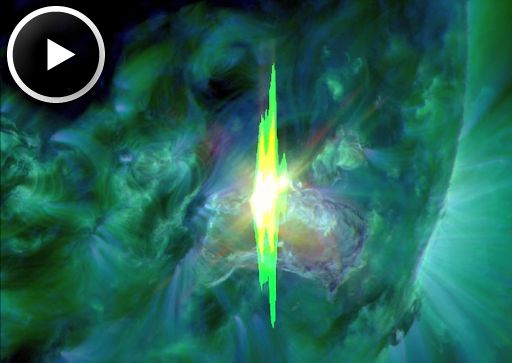 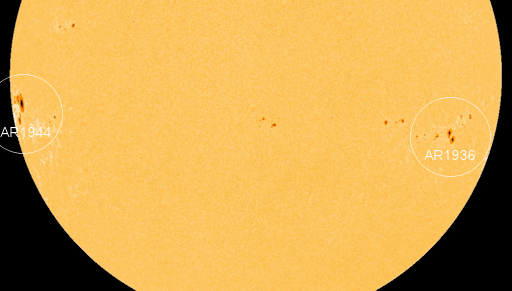 Astro Picture of the Day: January 2, 2014  That's not the young crescent Moon poised above the western horizon at sunset. Instead it's Venus in a crescent phase, captured with a long telephoto lens from Quebec City, Canada, planet Earth on a chilly December 30th evening. The very bright celestial beacon is droping lower into the evening twilight every day. But it also grows larger in apparent size and becomes a steadily thinner crescent in binocular views as it heads toward an inferior conjunction, positioned between the Earth and the Sun on January 11. The next few evenings will see a young crescent Moon join the crescent Venus in the western twilight, though. Historically, the first observations of the phases of Venus were made by Galileo with his telescope in 1610, evidence consistent with the Copernican model of the Solar System, but not the Ptolemaic system.
__________________
1st in Kommisar's 2009 SM Tournament 1st in I Love You`s 2009 New Year`s Tournament 3rd in EnR's Mashfest '08 tournament 5th in Phynx's Unofficial FFR Tournament 9th in D3 of the 2008-2009 4th Official FFR Tournament 10th in D5 of the 2010 5th Official FFR Tournament 10th in D6 of the 2011-2012 6th Official FFR Tournament FMO AAA Count: 71 FGO AAA Count: 10 Bluearrowll = The Canadian player who can not detect awkward patterns. If it's awkward for most people, it's normal for Terry. If the file is difficult but super straight forward, he has issues. If he's AAAing a FGO but then heard that his favorite Hockey team was losing by a point, Hockey > FFR PS: Cool AAA's Terry - I Love You An Alarm Clock's Haiku beep beep beep beep beep beep beep beep beep beep beep beep beep beep beep beep beep - ieatyourlvllol |
|
|

|
|
|
#794 |
|
⊙▃⊙
|
Daily Suspicious0bserver's Weather Post:
January 3, 2014 What's in the sky tonight? January 3, 2014 -Newly-discovered asteroid 2014 AA hit Earth's atmosphere on Jan. 2nd. The space rock, about the size of a small car, disintegrated over the Atlantic Ocean about 3,000 km east of Caracas, Venezuela. Infrasound records interpreted by Peter Brown of the University of Western Ontario suggest an impact energy between 500 and 1,000 tons of TNT. That's a lot of dynamite; nevertheless, in cosmic terms this was a relatively minor impact that did no damage to our planet. -After sunset, look far to the lower right of the waxing crescent Moon for Venus, dropping lower every day. How many more days can you keep Venus in view? It will reach inferior conjunction, 5° north of the Sun, on January 11th. -Venus (magnitude –4 or –3) is dropping to the southwest horizon after sunset. It passes through inferior conjunction, 5° north of the Sun, on January 11th. Seen with optical aid it's a hairline crescent a mere 2% sunlit or less. But it's big! About 60 arcseconds in diameter. -Sunspot AR1944, which emerged over the sun's eastern limb on Jan. 1st, is big and potentially dangerous. The complex region contains more than a dozen dark cores, and the leading spot is big enough to swallow two planet Earths all by itself. AR1944 is so large, sky watchers on Earth are beginning to notice it as a blemish on the solar disk at sunset. "This was my first sunset shot of the year," says photographer Raymund Sarmiento of Quezon City, the Philippines. "AR1944 is circled. That sunspot has the potential to disrupt transmission/reception of radio signals on the foreground antenna." Indeed, the sunspot has a 'beta-gamma' magnetic field that harbors energy for strong eruptions. NOAA forecasters estimate a 75% for M-flares and 30% for X-flares on Jan. 3rd. The effect of any flares today will be mitigated by the fact that the sunspot is not yet directly facing Earth. However, even an off-center blast from this behemoth could produce radio blackouts and geomagnetic activity. Stay tuned for developments. -For the second day in a row, a solar wind stream is buffeting Earth's magnetic field, sparking intermittant geomagnetic storms and auroras around the Arctic Circle. Last night, Northern Lights tour guide Chad Blakley photographed a luminous green vortex over Sweden's Abisko National Park. "Tonight was one of those nights that makes being an aurora photographer the best job in the world," says Blakley. "The lights started around 5:00 PM and continued well into the night. I had the pleasure of spending the evening with Peter Richards, a representative of National Geographic student photography expeditions. At one point during our night under the stars I heard him say that the display was the most amazing thing he had ever seen in his life - I couldn't agree more!" 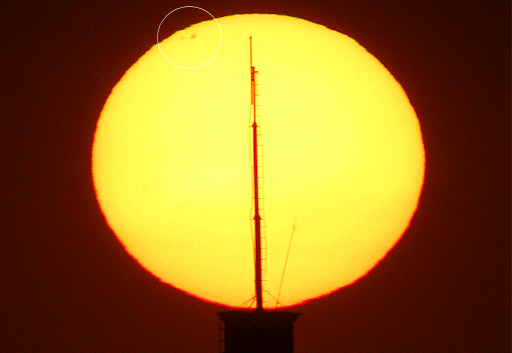 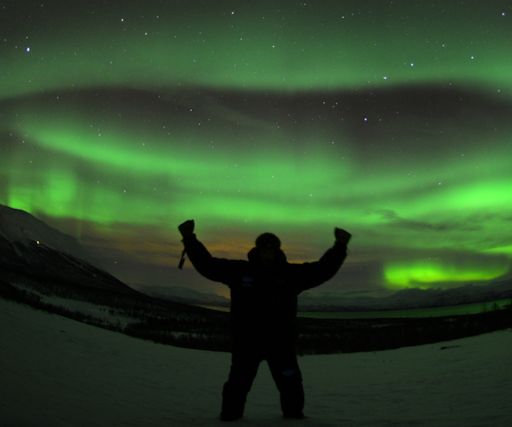 News Posted Today: January 2, 2014 Small Asteroid 2014 AA Hits Earth  Astro Picture of the Day: January 3, 2014 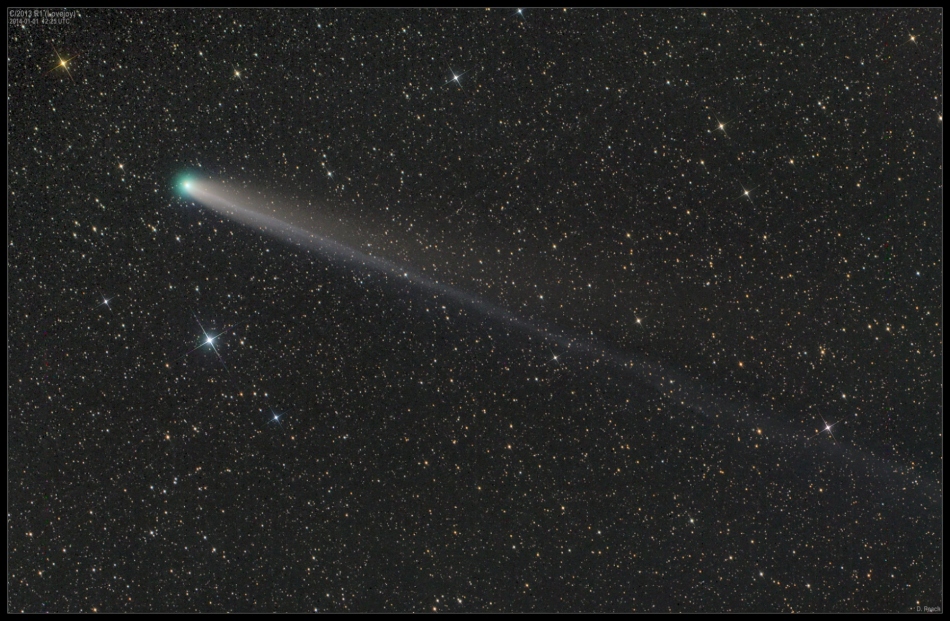 A rival to vanquished Comet ISON in 2013, Comet Lovejoy (C/2013 R1) still sweeps through early morning skies, captured in this starry scene on New Year's day. The frame stretches some 3.5 degrees across a background of faint stars in the constellation Hercules. Only just visible to the naked eye from dark sites before dawn, Lovejoy remains a good target for the northern hemisphere's binocular equipped skygazers. But this deep exposure shows off Lovejoy's beautiful tails and tantalizing greenish coma better than binocular views. Not a sungrazer, this Comet Lovejoy made its closest approach to the Sun around December 22, looping high above the ecliptic plane. Now headed for the outer Solar System, Lovejoy began the new year about 6.7 light-minutes from planet Earth.
__________________
1st in Kommisar's 2009 SM Tournament 1st in I Love You`s 2009 New Year`s Tournament 3rd in EnR's Mashfest '08 tournament 5th in Phynx's Unofficial FFR Tournament 9th in D3 of the 2008-2009 4th Official FFR Tournament 10th in D5 of the 2010 5th Official FFR Tournament 10th in D6 of the 2011-2012 6th Official FFR Tournament FMO AAA Count: 71 FGO AAA Count: 10 Bluearrowll = The Canadian player who can not detect awkward patterns. If it's awkward for most people, it's normal for Terry. If the file is difficult but super straight forward, he has issues. If he's AAAing a FGO but then heard that his favorite Hockey team was losing by a point, Hockey > FFR PS: Cool AAA's Terry - I Love You An Alarm Clock's Haiku beep beep beep beep beep beep beep beep beep beep beep beep beep beep beep beep beep - ieatyourlvllol |
|
|

|
|
|
#795 |
|
Banned
Join Date: Dec 2013
Posts: 3
|
This is the best thread on ffr, sadly there is 2 many words. But yeah, pretty cool.
|
|
|

|
|
|
#796 |
|
⊙▃⊙
|
Daily Suspicious0bserver's Weather Post:
January 4, 2014 What's in the sky tonight? January 4, 2014 -Soon after dark, Sirius, the Dog Star, rises below Orion. And Procyon, the Little Dog Star, rises to the lower right of bright Jupiter. Which of them comes up first? It's Procyon if you're north of latitude 30° (Tijuana, New Orleans, Jacksonville), and Sirius if you're south of there. Hint: "Procyon" means "Before the Dog." That tells you something about where its namers lived. -Sunspot AR1944, which appeared on January 1st, is one of the largest sunspots of the current solar cycle. It's so big, people are noticing it as a naked-eye blemish on the solar disk. Daisuke Tomiyasu sends this picture from Higashinada-ku, Kobe, Hyogo, Japan. "Sunspot 1944 was visible at sunrise on January 4th," says Tomiyasu. "I combined three exposures of 1/15sec, 1/100sec, and 1/640sec to create this HDR (high dynamic range) image." Although the sunspot has been relatively quiet and stable since it first appeared on New Year's Day, a region of this size has the potential to produce significant activity. Indeed, NOAA forecasters, who say they are keeping a close eye on this behemoth, estimate a 75% chance of M-flares and a 30% chance of X-flares on Jan. 4th. 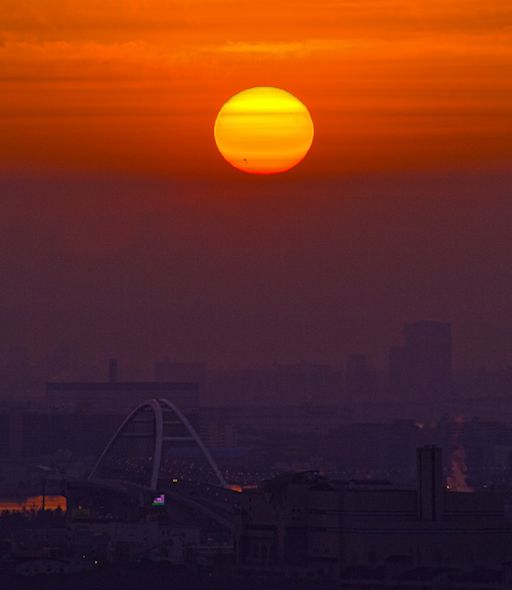 Astro Picture of the Day: January 4, 2014 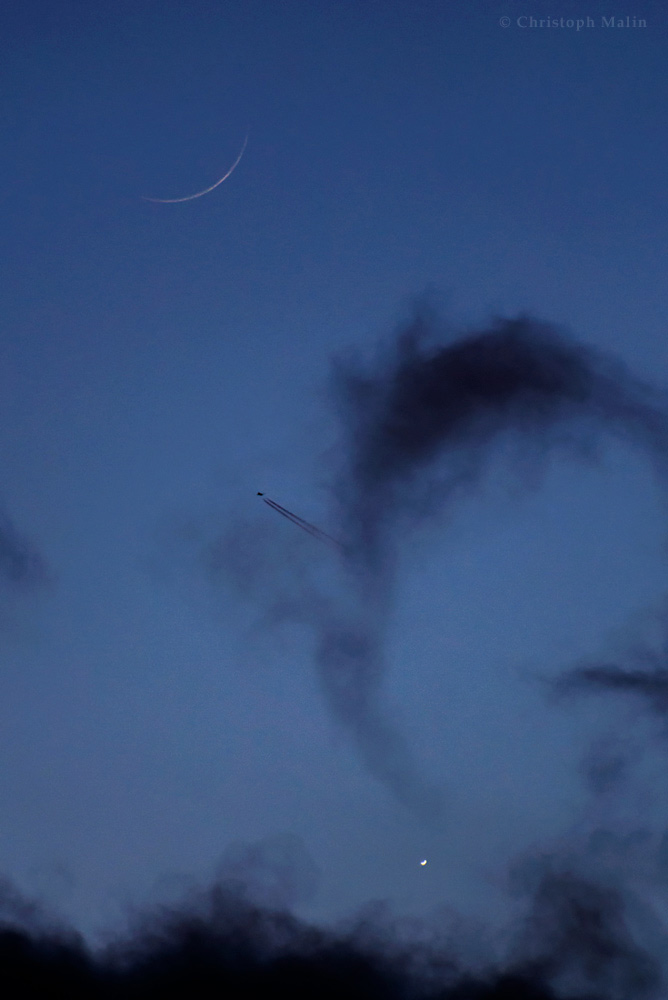 A crescent Venus shines along the western horizon at dusk in this clearing sky. The Earth's sister planet is smiling between the low clouds near the bottom of the frame during its January 2nd conjunction with the slender, young crescent Moon above. Of course the lovely pairing of Moon and Venus crescents could be enjoyed in the new year's skies around the the world. But the twin contrails in this scene belong to an aircraft above Appenzell, Switzerland. Soon to disappear from evening skies, Venus is heading toward its January 11th inferior conjunction and an appearance in predawn skies as planet Earth's morning star by late January. And the Moon will be young again, too.
__________________
1st in Kommisar's 2009 SM Tournament 1st in I Love You`s 2009 New Year`s Tournament 3rd in EnR's Mashfest '08 tournament 5th in Phynx's Unofficial FFR Tournament 9th in D3 of the 2008-2009 4th Official FFR Tournament 10th in D5 of the 2010 5th Official FFR Tournament 10th in D6 of the 2011-2012 6th Official FFR Tournament FMO AAA Count: 71 FGO AAA Count: 10 Bluearrowll = The Canadian player who can not detect awkward patterns. If it's awkward for most people, it's normal for Terry. If the file is difficult but super straight forward, he has issues. If he's AAAing a FGO but then heard that his favorite Hockey team was losing by a point, Hockey > FFR PS: Cool AAA's Terry - I Love You An Alarm Clock's Haiku beep beep beep beep beep beep beep beep beep beep beep beep beep beep beep beep beep - ieatyourlvllol |
|
|

|
|
|
#797 |
|
⊙▃⊙
|
Daily Suspicious0bserver's Weather Post:
January 5, 2014 What's in the sky tonight? January 5, 2014 -Jupiter is at opposition. All week it’s at its biggest and brightest for 2014. -Algol in Perseus, the prototype eclipsing binary star, should be in one of its periodic dimmings, magnitude 3.4 instead of its usual 2.1, for a couple hours centered on 8:24 p.m. EST. Algol takes several additional hours to fade and to rebrighten. -Giant sunspot AR1944 has developed a 'beta-gamma-delta' magnetic field that harbors energy for potent Earth-directed eruptions. NOAA forecasters estimate a 75% chance of M-class flares and a 30% chance of X-flares on Jan. 5th. -I have also included my own photos of the sunspot simply by pointing a DSLR at the sun with a 300mm lens and a neutral density filter. -A coronal mass ejection (CME) might be heading for Earth. The cloud blasted away from the sun during the late hours of Jan 4th following a long-duration M4-class solar flare from big sunspot AR1944. SOHO (the Solar and Heliospheric Observatory) recorded the explosion. -The assymetric CME could deliver a glancing blow to Earth's magnetic field in two or three days, possibly sparking polar geomagnetic storms. NOAA analysts are still processing the CME imagery for a more precise forecast. -Venus is turning its night side toward Earth as it approaches inferior solar conjunction on Jan. 11th. Less than 2% of Venus's sunlit hemisphere is now facing us, which means the planet looks like a razor-thin crescent. If you have a GOTO telescope, command it to slew to Venus. It's visible even in broad daylight. -Amateur astronomer Steven Bellavia of New York took the picture at noon on Jan. 4th using a Celestron C5 telescope. "This is the finest crescent Venus I have ever been able to photograph," he says. Observers who wish to try this for themselves can find Bellavia's photo details here. Be careful, though, because Venus is only 11o from the blinding sun. 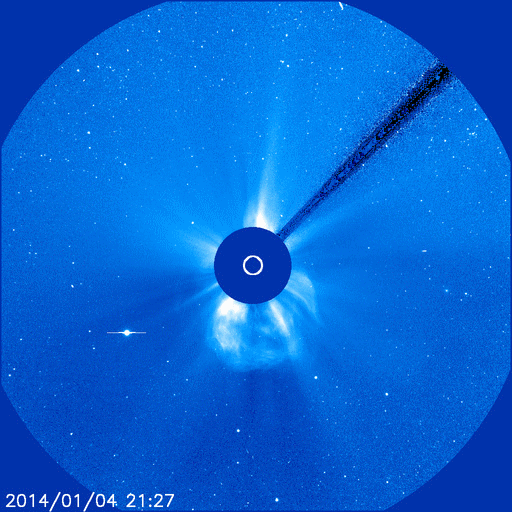   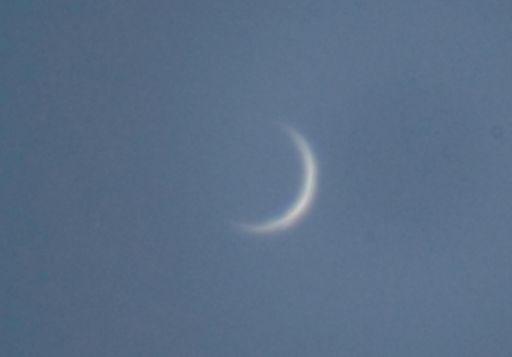 News Posted Today: January 4, 2014 Huge Sunspot Group Now Observable  Astro Picture of the Day: January 5, 2014 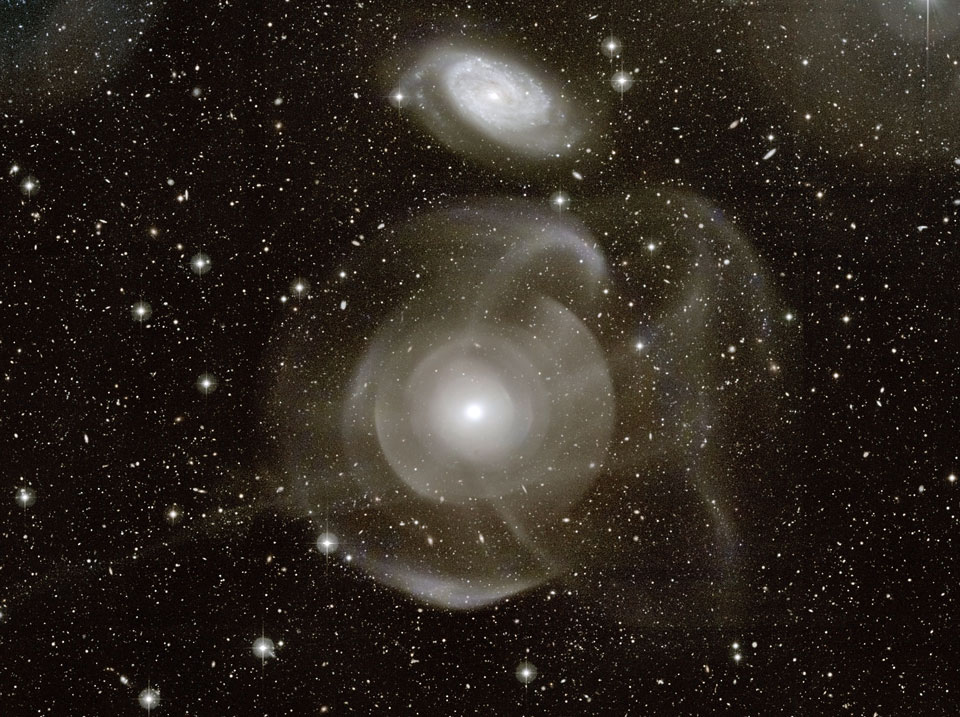 A crescent Venus shines along the western horizon at dusk in this clearing sky. The Earth's sister planet is smiling between the low clouds near the bottom of the frame during its January 2nd conjunction with the slender, young crescent Moon above. Of course the lovely pairing of Moon and Venus crescents could be enjoyed in the new year's skies around the the world. But the twin contrails in this scene belong to an aircraft above Appenzell, Switzerland. Soon to disappear from evening skies, Venus is heading toward its January 11th inferior conjunction and an appearance in predawn skies as planet Earth's morning star by late January. And the Moon will be young again, too.
__________________
1st in Kommisar's 2009 SM Tournament 1st in I Love You`s 2009 New Year`s Tournament 3rd in EnR's Mashfest '08 tournament 5th in Phynx's Unofficial FFR Tournament 9th in D3 of the 2008-2009 4th Official FFR Tournament 10th in D5 of the 2010 5th Official FFR Tournament 10th in D6 of the 2011-2012 6th Official FFR Tournament FMO AAA Count: 71 FGO AAA Count: 10 Bluearrowll = The Canadian player who can not detect awkward patterns. If it's awkward for most people, it's normal for Terry. If the file is difficult but super straight forward, he has issues. If he's AAAing a FGO but then heard that his favorite Hockey team was losing by a point, Hockey > FFR PS: Cool AAA's Terry - I Love You An Alarm Clock's Haiku beep beep beep beep beep beep beep beep beep beep beep beep beep beep beep beep beep - ieatyourlvllol |
|
|

|
|
|
#798 |
|
⊙▃⊙
|
Daily Suspicious0bserver's Weather Post:
January 6, 2014 What's in the sky tonight? January 6, 2014 -Jupiter’s Great Red Spot crosses the planet’s central meridian around 9:53 p.m. EST. One of the largest sunspots in years, AR1944, is turning toward Earth. The active region contains dozens of dark cores, the largest of which is big enough to swallow three planet Earths. It's so big, sky watchers are noticing it as a blemish on the solar disk at sunset. "Sunspot AR1944 was visible without using a solar telescope," reports Eddie Irizarry of Rincon, Puerto Rico, who took this picture at the end of the day on Jan. 5th. "Proper filters and extreme care should be taken when photographing the sun," he adds. "Unfiltered sunlight magnified by optics can cause serious eye damage." Astronomers who have a safe solar telescope are encouraged to take a closer look. "AR1944 has to be the most awesome sunspot ever," says Sergio Castillo of Inglewood, CA. "I cannot stop photographing it." His latest image from Jan. 5th is shown below. Castillo used a telescope capped with a "Calcium K" filter. Calcium K filters, which are sensitive to the blue glow of calcium ions in the sun's lower atmosphere, highlight the bright magnetic froth that often forms around a sunspot's dark cores. AR1944 is very frothy indeed. Magnetic froth does not necessarily herald an explosion, but it does guarantee a photogenic sunspot. Scan the gallery for more images: 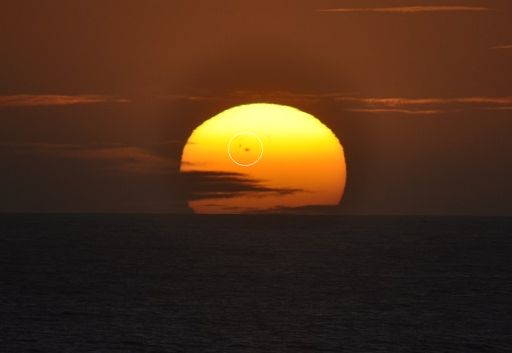 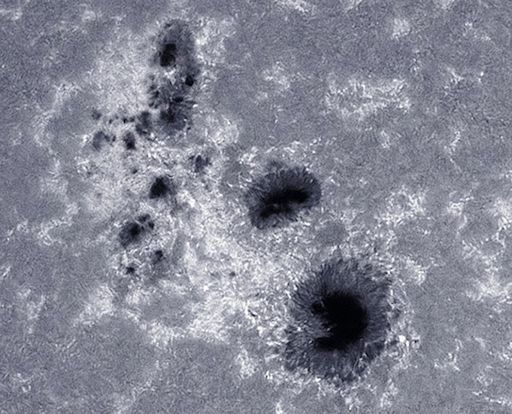 Astro Picture of the Day: January 6, 2014 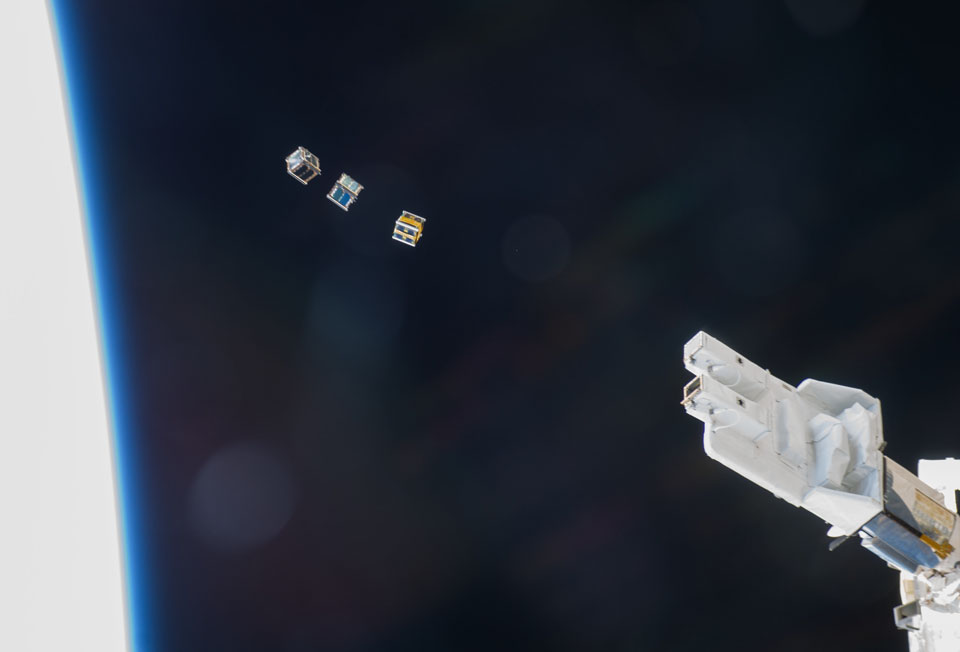 Cubes are orbiting the Earth. Measuring ten-centimeters on a side, CubeSats - each roughly the size of a large coffee mug -- are designed to be inexpensive both to build and to launch. Pictured above, three CubeSats were released from the International Space Station (ISS) last November by the arm of the Japanese Kibo Laboratory module. CubeSats are frequently created by students as part of university science or engineering projects and include missions such as collecting wide angle imagery of the Earth, testing orbital radio communications, monitoring the Earth's magnetic field, and exploring the Earth's surrounding radiations. Depending on the exact height of their release, CubeSats will re-enter the Earth's atmosphere on the time scale of months to years.
__________________
1st in Kommisar's 2009 SM Tournament 1st in I Love You`s 2009 New Year`s Tournament 3rd in EnR's Mashfest '08 tournament 5th in Phynx's Unofficial FFR Tournament 9th in D3 of the 2008-2009 4th Official FFR Tournament 10th in D5 of the 2010 5th Official FFR Tournament 10th in D6 of the 2011-2012 6th Official FFR Tournament FMO AAA Count: 71 FGO AAA Count: 10 Bluearrowll = The Canadian player who can not detect awkward patterns. If it's awkward for most people, it's normal for Terry. If the file is difficult but super straight forward, he has issues. If he's AAAing a FGO but then heard that his favorite Hockey team was losing by a point, Hockey > FFR PS: Cool AAA's Terry - I Love You An Alarm Clock's Haiku beep beep beep beep beep beep beep beep beep beep beep beep beep beep beep beep beep - ieatyourlvllol Last edited by Bluearrowll; 01-6-2014 at 04:56 PM.. |
|
|

|
|
|
#799 | |
|
"Reach For The Stars"
|
Oh wow, I saw an article about those CubeSats. Very cool information, I hope that the satellites will become less and less expensive to build as time goes on. Unfortunately, that also means traffic in space orbiting earth will become much more clustered together. Hopefully we can provide alternatives that bring them down once their use is finished like ie. After a 4 year period, your CubeSat must be taken out of space and brought back to earth.
__________________
Quote:
 |
|
|
|

|
|
|
#800 |
|
⊙▃⊙
|
Daily Suspicious0bserver's Weather Post:
January 7, 2014 What's in the sky tonight? January 7, 2014 -First-quarter Moon (exact at 10:39 p.m. EST). Look to the right of the Moon this evening for the Great Square of Pegasus, tipped up onto one corner. The main line of Andromeda’s stars extends up from its top. -NOAA forecasters estimate a 70% chance of polar geomagnetic storms on Jan. 7th when a CME is expected to deliver a glancing blow to Earth's magnetic field. The CME was hurled in our direction by an M4-class explosion from giant sunspot AR1944 on Jan. 4th. High latitude sky watchers should be alert for auroras. -One of the biggest sunspots in years is crossing the center of the solar disk, putting Earth in the way of potential eruptions. Rocky Raybell photographed the active region named "AR1944" yesterday from his backyard in Keller, Washington. -The sprawling sunspot contains dozens of dark cores, the largest big enough to swallow Earth three times over. This makes it an easy target for amateur solar telescopes. Raybell used a backyard 'scope capped with a Baader solar filer to capture both the sunspot and trees in the foreground. 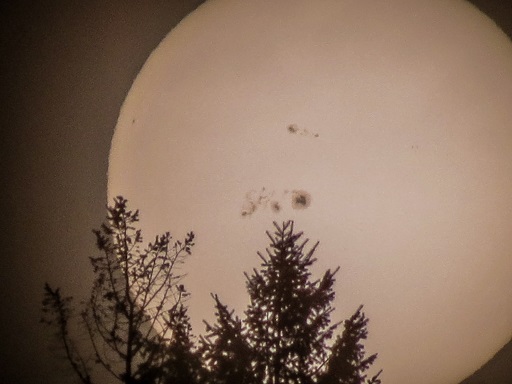 Astro Picture of the Day: January 7, 2014  M7 is one of the most prominent open clusters of stars on the sky. The cluster, dominated by bright blue stars, can be seen with the naked eye in a dark sky in the tail of the constellation of the Scorpion (Scorpius). M7 contains about 100 stars in total, is about 200 million years old, spans 25 light-years across, and lies about 1000 light-years away. The above deep image, taken last June from Hungary through a small telescope, combines over 60 two-minute exposures. The M7 star cluster has been known since ancient times, being noted by Ptolemy in the year 130 AD. Also visible are a dark dust cloud and literally millions of unrelated stars towards the Galactic center.
__________________
1st in Kommisar's 2009 SM Tournament 1st in I Love You`s 2009 New Year`s Tournament 3rd in EnR's Mashfest '08 tournament 5th in Phynx's Unofficial FFR Tournament 9th in D3 of the 2008-2009 4th Official FFR Tournament 10th in D5 of the 2010 5th Official FFR Tournament 10th in D6 of the 2011-2012 6th Official FFR Tournament FMO AAA Count: 71 FGO AAA Count: 10 Bluearrowll = The Canadian player who can not detect awkward patterns. If it's awkward for most people, it's normal for Terry. If the file is difficult but super straight forward, he has issues. If he's AAAing a FGO but then heard that his favorite Hockey team was losing by a point, Hockey > FFR PS: Cool AAA's Terry - I Love You An Alarm Clock's Haiku beep beep beep beep beep beep beep beep beep beep beep beep beep beep beep beep beep - ieatyourlvllol |
|
|

|
 |
| Currently Active Users Viewing This Thread: 1 (0 members and 1 guests) | |
|
|